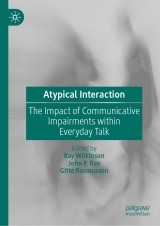Details

Atypical Interaction
The Impact of Communicative Impairments within Everyday Talk|
171,19 € |
|
| Verlag: | Palgrave Macmillan |
| Format: | |
| Veröffentl.: | 18.04.2020 |
| ISBN/EAN: | 9783030287993 |
| Sprache: | englisch |
Dieses eBook enthält ein Wasserzeichen.
Beschreibungen
<p><i>Atypical Interaction</i> presents a state-of-the-art overview of research which uses conversation analysis to explore how communicative impairments impact on conversation and other forms of talk and social interaction. Although the majority of people use spoken language unproblematically in social interaction, many individuals have an atypical capacity for communication. The first collection of its kind, this book examines a wide range of conditions where the communication of children or adults is atypical, including autism spectrum disorder, dementia, stammering, hearing impairment, schizophrenia, dysarthria and aphasia. By analyzing recordings of real-life interactions, the collection highlights not only the communication difficulties and challenges faced by atypical communicators and their interlocutors in everyday life, but also the competences and often novel forms of communication displayed. </p><p>With fourteen empirical chapters from leading scholars in the field and an introductory chapter which provides a background to conversation analysis and its application to the study of atypical interactions, the collection will be an invaluable resource for students, practitioners such as speech and language therapists, and researchers with an interest in human communication, communication diversity and disorder.<br></p><p></p>
<p></p><p>Chapter 1 Atypical Interaction: An Introduction; Ray Wilkinson, John Rae & Gitte Rasmussen.- Chapter 2 Sequence and Consequence: Transposing Responsive Actions Into Provocations in Forensic and Clinical Encounters Involving Youths with Autism; Douglas W. Maynard, Jason Turowetz.- Chapter 3 Making and taking opportunites for co-participation in an interaction between a boy with autism spectrum disorder and his father; John P. Rae, Monica Ramey.- Chapter 4 Difficulties facing people with intellectual disability in conversation: initiation, co-ordination, and the problem of asymmetric competence; Chris Walton, Charles Antaki, and W.M.L. Finlay.- Chapter 5 Does Atypicality Entail Impairment? Tracing the Use of a Cohesive Marker in the Interactions of an Individual with Schizophrenia; Lisa Mikesell.- Chapter 6 Singing as a resource in conversations involving persons with dementia; Gitte Rasmussen.- Chapter 7 Dementia in Conversation: Observations from Triadic Memory Clinic Interactions; Christopher Elsey.- Chapter 7 Dementia in Conversation: Observations from Triadic Memory Clinic Interactions; Christopher Elsey.- Chapter 9 Repair organization in linguistically asymmetric interaction: comparing child-parent conversations and conversations involving speakers with aphasia; Minna Laakso.- Chapter 10 Increasing learner authority in the classrooms of children with speech language and communication needs; Julie Radford.- Chapter 11 ‘My own space in this world’: Stammering, telephone calls, and the progressivity and permeability of turns-at-talk; Ray Wilkinson, Sarah Morris.- Chapter 12 Person reference as a trouble source in dysarthric talk-in-interaction; Steven Bloch, Charlotta Saldert.- Chapter 13 How can the ‘autonomous speaker‘ survive in atypical interaction? The case of anarthria and aphasia; Peter Auer, Angelika Bauer and Ina Hörmeyer.- Chapter 14 Practices of negotiating responsibility for troubles in interaction involving people with hearing impairment in Australia; Katie Ekberg, Louise Hickson, and Christopher Lind.- Chapter 15 Resources for repair initiation in a Swiss German classroom and a Swiss German Sign Language classroom; Simone Girard-Groeber.</p><p></p>
<div><div>Ray Wilkinson is Professor of Human Communication at the University of Sheffield, UK. He has a clinical background in speech and language therapy. His research interests focus on everyday social interaction, in particular where participants do not have the communicative resources available to neurotypical adult native language speakers. </div><div><br></div><div>John P. Rae is Reader in Psychology in the Department of Psychology at the University of Roehampton, UK. He has a BA in Philosophy and Psychology and a PhD in Psychology, both from the University of Leeds. He is interested in how people use talk and visible action in social interaction. </div><br></div><div>Gitte Rasmussen is Professor of Social Interaction in the Department of Language and Communication at the University of Southern Denmark. Her research interests concern how people organize social activities and interactions and how they design their talk and visual actions in accordance with their assumptions about each other’s knowledge.</div><div><br></div>
<p>Presents new findings on how communication impairments impact on everyday social interactions</p><p>Offers unique coverage of both acquired and developmental forms of atypical interaction</p><p>Highlights not only the communication difficulties but also the competences and novel forms of communication displayed by atypical communicators</p>

















